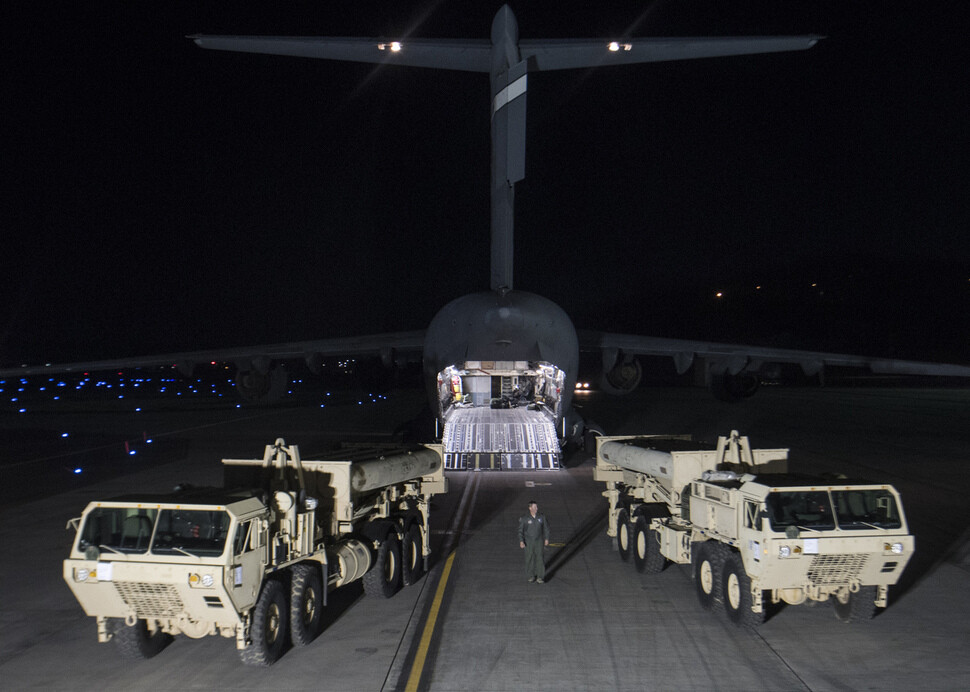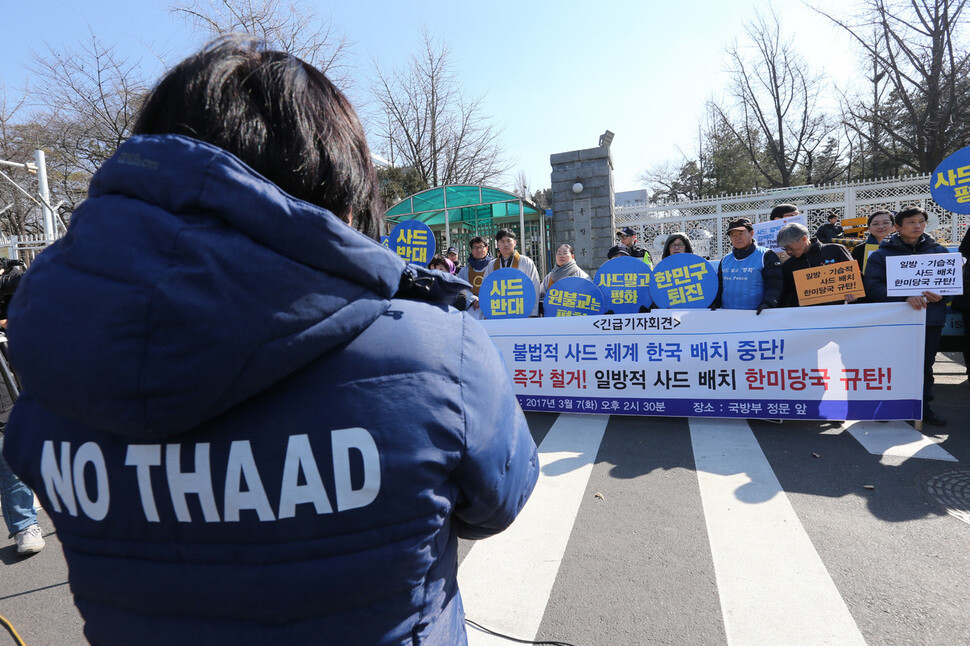hankyoreh
Links to other country sites 다른 나라 사이트 링크
[Editorial] Ramming through THAAD deployment both irresponsible and dangerous

The South Korean and US militaries announced on Mar. 7 that they had already begun work on deploying the THAAD missile defense system in South Korea. They started shipping the equipment into the country even before the deployment site was prepared. Barging ahead like this is both rash and irresponsible. It’s also a heavy-handed attempt to quash resistance from civic groups and opposition parties calling for the THAAD deployment to be reconsidered and from China, which has initiated economic retaliation against South Korea. The move also appears to have political undertones, targeting the presidential election that will take place after the upcoming decision about the impeachment of President Park Geun-hye. We hope that the South Korean and US governments will immediately suspend the THAAD deployment.
Just as with the announcement of the THAAD deployment in July 2016, the South Korean government once again appears to be forcing an extreme choice on the country without a period of rational debate. This is even more immoral now, when power is in the hands of Prime Minister and acting president Hwang Kyo-ahn. A government source said that the THAAD battery will be deployed in Seongju as early as April. This makes clear that the government’s attempt to rush the deployment is designed to make THAAD a fait accompli before the next administration takes power. This is an attempt that goes against the public to forestall any reconsideration of the THAAD deployment, despite the many problems with the plan and the way it is being carried out. The justification given by the government is the increasing threat of North Korea‘s nuclear weapons and missiles, but the situation will not change much over a few months. The only direct link between THAAD and addressing the threat of nuclear weapons and missiles is the implausible claim that THAAD is a cure-all.
US President Donald Trump and the US government are also making the mistake of undermining the security order in Northeast Asia and exacerbating the North Korean nuclear issue. The US has pursued the deployment of THAAD on the Korean Peninsula as a key means of bringing about the military and security integration of South Korea, the US and Japan. A key American strategy in Asia that is aimed at China is using integration of missile defense to definitely incorporate South Korea into the US-Japan alliance as a junior partner. Rushing forward with THAAD is effectively the first overseas military action by Trump, who has advocated peace through strength. This action, which is taking place even before the Trump administration has finalized its approach to foreign policy and national security, illustrates the unilateral nature of that administration.
It’s not easy to predict the ramifications of ramming through THAAD like this. There will obviously be a strong backlash from China, which will probably involve economic, diplomatic and military measures. This is especially true considering that the South Korean and US governments have effectively abandoned any serious deliberation with China on the THAAD issue. When China claims that THAAD is infringing its strategic interests, the US actually seems to regard this as augmenting its own strategic interests, and the South Korean government only repeats the claim that the THAAD deployment has nothing to do with China. Until a compromise is reached on the US and China‘s strategic perspective, South Korea is likely to remain a target for retaliation. We should assume that the current economic sanctions are just the beginning. But the government has failed to offer any practical solutions either for South Korea’s relations with China or for the nuclear issue. This attitude is not only inept - it’s dangerous.
If the US and South Korea’s conflict with China intensifies, it will inevitably make it even harder to find a solution to the North Korean nuclear issue. The THAAD conflict is already serving to reinforce a “neo-Cold War” alignment of South Korea, the US and Japan against North Korea, China and Russia. Under such an alignment, China has less incentive to take action to resolve the North Korean nuclear issue. This means that while the THAAD deployment is supposed to be countering the threat of North Korea’s nuclear weapons and missiles, it’s ultimately just making the nuclear problem worse.
Ramming through THAAD is the epitome of the failed foreign policy and security policy of the administration of President Park Geun-hye. Even if the administration succeeds at quickly deploying the THAAD battery, the side effects are too great. The right choice is to let the next administration make the final decision.

Please direct questions or comments to [english@hani.co.kr]

Editorial・opinion
![[Editorial] Does Yoon think the Korean public is wrong? [Editorial] Does Yoon think the Korean public is wrong?](https://flexible.img.hani.co.kr/flexible/normal/500/300/imgdb/original/2024/0417/8517133419684774.jpg) [Editorial] Does Yoon think the Korean public is wrong?
[Editorial] Does Yoon think the Korean public is wrong?![[Editorial] As it bolsters its alliance with US, Japan must be accountable for past [Editorial] As it bolsters its alliance with US, Japan must be accountable for past](https://flexible.img.hani.co.kr/flexible/normal/500/300/imgdb/original/2024/0417/6817133413968321.jpg) [Editorial] As it bolsters its alliance with US, Japan must be accountable for past
[Editorial] As it bolsters its alliance with US, Japan must be accountable for past- [Guest essay] Amending the Constitution is Yoon’s key to leaving office in public’s good graces
- [Editorial] 10 years on, lessons of Sewol tragedy must never be forgotten
- [Column] A death blow to Korea’s prosecutor politics
- [Correspondent’s column] The US and the end of Japanese pacifism
- [Guest essay] How Korea turned its trainee doctors into monsters
- [Guest essay] As someone who helped forge Seoul-Moscow ties, their status today troubles me
- [Editorial] Koreans sent a loud and clear message to Yoon
- [Column] In Korea’s midterm elections, it’s time for accountability
Most viewed articles
- 1[Column] The clock is ticking for Korea’s first lady
- 2[Guest essay] How Korea turned its trainee doctors into monsters
- 3Samsung barricades office as unionized workers strike for better conditions
- 4S. Korea, Japan reaffirm commitment to strengthening trilateral ties with US
- 5[Editorial] When the choice is kids or career, Korea will never overcome birth rate woes
- 6Gangnam murderer says he killed “because women have always ignored me”
- 7[Editorial] As it bolsters its alliance with US, Japan must be accountable for past
- 8[News analysis] After elections, prosecutorial reform will likely make legislative agenda
- 9Korea, Japan jointly vow response to FX volatility as currencies tumble
- 10US exploring options for monitoring N. Korean sanctions beyond UN, says envoy